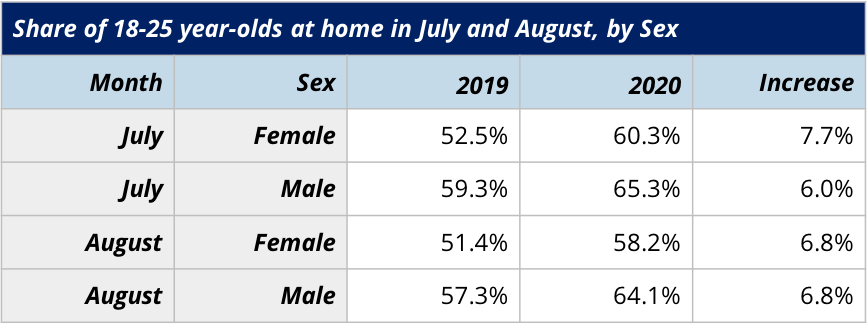- 61.2% of U.S. 18-25 year-olds lived with a parent or grandparent in August, down from 62.8% earlier in the summer but still well above 54.4% in August 2019.
- The rise is sharpest among young Black Americans.
- The share of women moving home rose faster than men early in the pandemic, but the differences have since evened out.
After rising dramatically in the Spring, the number of young adults nationwide living with parents or grandparents has begun to fall — though it still remains extraordinarily high.
As of August 2020, 61.2% of 18-to-25-year-olds were living with parents or grandparents, down from a peak of 62.8% in July. But that's still well above the 54.4% that did so in August 2019, representing almost 2 million more young adults nationwide living at home compared to a year ago (20.2 million in August 2020, 18.2 million in August 2019). Among older adults aged 26 and up, there is now no measurable difference in the share living with their parents or grandparents compared to a year ago.
This rise in Gen Z moving home has been driven by several forces: Rising unemployment that left young adults unable to pay for their own home; a desire among many families to shelter in place together; and/or the forced return home of students from college and uncertain return dates as the traditional "back to school" season remains in flux.

Fading “She-Cession” Impacts
At the peak of the trend in July, it appeared that young women were more likely to move home, contributing to discussions of a so-called "she-cession" in which women were being disproportionately impacted by the negative economic effects of the pandemic. In July, the share of young adult women living with parents was up 7.7 percentage points from the same time in 2019 (from 52.5% to 60.3%), compared to a 6 percentage point rise for young men over the same period (59.3% to 65.3%). But by August, the gaps evened out, with the share of both groups living at home now each up by 6.8 percentage points percentage points. Their current levels reflect a longstanding, pre-pandemic tendency[1] for more young men (currently 64.1%) than young women (currently 58.2%) to live at home.
Black Americans Disproportionately Impacted
Young Black Americans are both the most likely to live at home, and have experienced the biggest jump from a year ago.[2] In August, the share of Black 18-to-25-year-olds living with a parent or grandparent stood at 65.7%, up from 56.5% the same time last year. Asian and Pacific Islander young adults also saw a stark jump, to 56.1% from 47.4% a year ago, though the current share of this group living at home remains the lowest among major groups analyzed.

At Home, and Unemployed
And the data indicate that a majority of these young adults living at home aren't doing so just to keep Mom and Dad company — there's likely an economic need, too. Just under half (49.5%) of the young adults in these data who are living with parents are employed,[3] down significantly from last August, when 56.6% were working. The absolute number of employed young adults living at home fell only slightly year-over-year in August, from 10.3 million to 10 million. But the number of young adults living at home who are not employed jumped from 7.9 million to 10.2 million. Even so, that still represents a sharp decline from earlier this spring, when stay-at-home orders and layoffs first swept the country. In April, a staggering 13.1 million young adults were living with parents and not employed, up from 8.5 million (or a 53% jump) from pre-pandemic conditions in February.

So What?
How this trend unfolds for the rest of the year will likely depend on the course of the virus and the economic recovery. Data in August indicated that the economic recovery for young adults living with parents slowed significantly compared to earlier in the year: The number who are not employed only inched down by 131,000, after falling over 800,000 in May, June, and July. If the pace of recovery doesn't pick back up, it will take many months before the number of young adults at home falls back to normal levels-particularly the count of young adults out of work. A prolonged setback would leave many members of Generation Z delayed by years on their road to independence, much as the Millennial generation was set back by the Great Recession, which began almost 13 years ago.
[1] In 2019, there was on average a gap of 6.0 percentage points between the shares of young men and young women living with parents, approximately the same gap as in August 2020.
[2] There is some evidence that the share of young Black Americans living with parents was increasing above seasonal trend levels already in February, before the pandemic, but the majority of the year-over-year rise has occurred since then. The share living with parents was 60.2% in February 2020, or 2.3 percentage points above the rate of 57.9% in February 2019.
[3] These statuses include both codes 10 (At work), and 12 (Has job, not at work last week) in the IPUMS-coded variable EMPSTAT. The share who are not employed is not quite the same as an unemployment rate, because it includes many young adults who are not in the labor force. The share employed is most commonly referred to as the employment-population ratio, a broader metric of labor market health not directly affected by the labor force participation rate.
The post The Share of Gen Z Living at Home is Falling, But Remains Very High appeared first on Zillow Research.
via The Share of Gen Z Living at Home is Falling, But Remains Very High


No comments:
Post a Comment